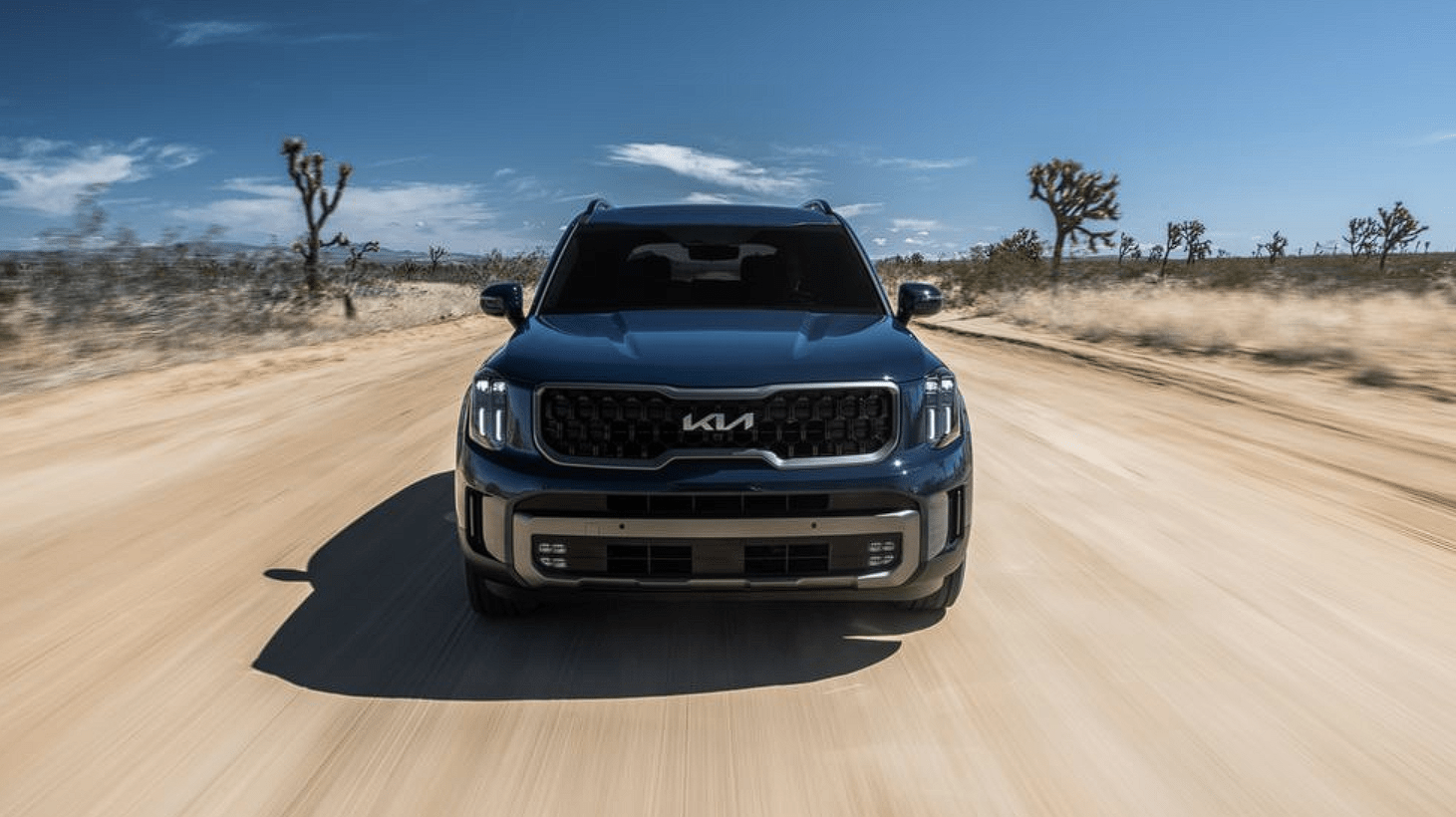Kia Telluride 2023 Forward Collision-Avoidance Assist (FCA) (Sensor Fusion)
In the ever-changing world of car safety, the 2023 Kia Telluride comes with a cutting-edge marvel called Forward Accident-Avoidance Assist (FCA). This is a revolutionary system that is meant to push the limits of accident prevention. At the heart of this technological wonder is Sensor Fusion, a group of radar and camera-based sensors that work together to find possible dangers on the road ahead. The 2023 Telluride’s FCA system goes beyond basic safety features because it not only warns the driver of approaching collisions but can also apply the brakes automatically if needed, adding an extra layer of protection in dangerous situations. Because it is always focused on safety and combines new technology and accuracy so well,
the 2023 Kia Telluride with FCA is a great example of Kia’s commitment to changing the future of safety in cars.
Forward Collision-Avoidance Assist (FCA) (Sensor Fusion)
Basic function

Forward Collision-Avoidance Assist is designed to help detect and monitor the vehicle ahead or help detect a powered two-wheeler, pedestrian or cyclist in the roadway and warn the driver that a collision is imminent with a warning message and warning and apply emergency braking.
Forward Collision-Avoidance Assist will detect vehicles ahead and adjacent lanes even at high speeds. If the driver makes a lane change at those speeds, your vehicle will apply emergency braking to mitigate or avoid a collision (if equipped).
2023 Kia Telluride Specs, Price, Features, Milage (brochure)
Junction Turning function

When turning left at a crossroad with the turn signal on, the vehicle will assist the driver in braking control to mitigate or avoid a collision with an oncoming vehicle.
Junction Crossing function (if equipped)

The Junction Crossing function will help avoid a collision with oncoming vehicles on the left or right side when crossing an intersection by applying emergency braking.
Lane-Change Oncoming function (if equipped)
 [A] : Oncoming vehicle
[A] : Oncoming vehicle
Lane-Change Oncoming function will help avoid a collision with an oncoming vehicle when changing lanes by assisting the driver’s steering.
Lane-Change Side function (if equipped)

[A]: Front-side vehicle
The lane-change Side function will help avoid a collision with the vehicle in the next lane when changing lanes by assisting the driver’s steering.
Evasive Steering Assist function (if equipped)

- Driver steering assist If a possible collision with a vehicle ahead, pedestrian, or cyclist is detected and the driver steers to avoid the collision, it will assist the driver in steering.
- Evasive steering assist The Evasive Steering Assist function helps avoid a collision with a pedestrian or cyclist ahead in the same lane. When a risk or collision is detected, it will warn the driver and if there is space to avoid collision in the lane, it will assist the driver’s steering.
Detecting sensor
Front view camera

Front radar

Front corner radar (if equipped)

Rear corner radar (if equipped)

Refer to the picture above for the detailed location of the detecting sensors.
CAUTION
- Never disassemble the detecting sensor or sensor assembly, or cause any damage to it.
- If the detecting sensors have been replaced or repaired, have the vehicle inspected by an authorized Kia dealer.
- If the radar or around the radar experiences an impact, Forward Collision-Avoidance Assist may not operate properly even if a warning message is not displayed on the cluster.
- Never install any accessories or stickers on the front windshield, or tint the front windshield.
- Pay extreme caution to keep the front view camera dry.
- Never place any reflective objects (for example, white paper or, mirror) over the dashboard.
- Do not place any objects near the front windshield or install any accessories on the front windshield. It can affect the performance of the defogging and defrosting function of the cli-mate control system, which may prevent the Driver Assistance systems from operating.
- Do not change the position of the license plate or apply the license plate frame. This may adversely affect the detecting performance of the front radar.
- Always keep the front radar and cover clean and free of dirt and debris. Use only a soft cloth to wash the vehicle. Do not spray pressurized water directly on the sensor or sensor cover.
- The genuine Kia front radar sensor covers are parts with quality and performance ensured. If arbitrarily applying paint on or changing the cover, Forward Collision-Avoidance Assist may not function properly. Use only Kia Genuine Parts or those of an equivalent standard with proven quality and performance to repair or replace the radar sensor covers.
- Do not arbitrarily apply paint, license plate molds, vehicle accessories, wraps, and stickers on or around the detecting sensor.
- Replacing the bumper or repairing (or painting) on around the front/rear corner radar can reduce the detecting performance of Forward Collision-Avoidance Assist.
- Installing a trailer, a carrier (a bike rack), or other equipment may adversely affect the detecting performance of the rear corner radar or temporarily limit Forward Collision-Avoidance Assist.
Forward Collision-Avoidance Assist settings
Forward safety
 A: Driver assistance
A: Driver assistance
- Driving safety
- Forward safety
With the vehicle on, touch Settings → Vehicle → Driver Assistance → Driving Safety on the infotainment system screen to set whether or not to use each function.
- Forward safety: Collision warning or emergency braking will operate in a collision-imminent situation. If you deselect the setting, Forward safety will turn off and the warning light ( ) will appear on the cluster.
Forward cross-traffic safety (if equipped)
 A: Driver assistance
A: Driver assistance
- Forward safety
- Forward cross-traffic safety
With the vehicle on, select Settings → Vehicle → Driver assistance → Driving safety → Forward cross-traffic safety from the infotainment system screen to turn on Junction Crossing function and deselect to turn off the function.- Forward cross-traffic safety: Depending on the collision risk levels, with oncoming vehicles on the left or right side when crossing an intersec-tion, an audible warning will sound, and the braking will be assisted.
Forward/side safety (if equipped)

A: Driver assistance
- Driving safety
- Forward/side safety
With the vehicle on, touch Settings → Vehicle → Driver assistance → Driving safety → Forward/side safety on the infotainment system. The forward and side vehicle detection function of For-ward Collision-Avoidance Assist will be activated.- Forward/side safety: Collision warning or emergency steering will assist the driver in a collision-imminent situation. If you deselect the setting, For-ward safety will turn off and the warning light ( ) will appear on the cluster.
The driver can monitor Forward Collision-Avoidance Assist On/Off status from the Settings menu. If the Forward Safety warning light ( ) or Emergency steering warning light ( ) remains ON when Forward safety or Forward/side safety is selected, have the vehicle inspected by an authorized Kia dealer.
WARNING
When the vehicle is restarted, Forward Collision-Avoidance Assist will always turn on. However, if Forward safety is deselected, the driver should always be aware of the surroundings and drive safely.
CAUTION
- Forward safety provides a ‘Basic Function’ and ‘Junction Turning function’. Forward Cross-Traffic Safety provides ‘Junction Crossing function’ and For-ward/Side Cross-Traffic Safety pro-vides ‘Lane change oncoming function’, ‘Lane change side function’ and ‘Evasive Steering Assist function’ (if equipped).
- If Forward safety is deselected, Even if Forward Cross-Traffic safety and Forward/Side Cross-Traffic Safety is selected, the ‘Junction Crossing function’ will not operate. (if equipped)
Forward Safety Warning Timing

A: Driving Safety
- Forward safety warning timing
- Standard
- Late
With the vehicle on, touch Settings → Vehicle → Driver Assistance→ Driving Safety → Forward Safety Warning Timing on the infotainment system to change the initial warning activation timing of Forward Collision-Avoidance Assist.- Use Standard in normal driving conditions. If the Forward Safety Warning Timing seems sensitive, change it to Late.
- If Late is selected, Forward Collision-Avoidance Assist warns the driver a little later.
CAUTION
- Even though Standard is selected for Forward Safety Warning Timing, if the front vehicle suddenly stops, the warning may seem late.
- Select Late for Warning Timing when traffic is light and when driving speed is slow.
NOTICE
- Warning timing setting does not apply on forwarding/side safety.
- The warning timing you have set will be maintained even if the vehicle is restarted.
Warning Methods

A: Driver Assistance
- Warning Methods
- Warning Volume
- Driving Safety Priority
With the vehicle on, touch Settings → Vehicle → Driver Assistance → Warning Methods on the infotainment system to change the Warning Sound.- Warning Volume: You can adjust the Warning Volume from level 1 to 3.
- Driving Safety Priority: For safe driving, the audio volume will temporarily decrease to warn the driver with the audible warning.
NOTICE
- Ensure that the Warning Sound and Haptic you have set may apply to the Warning volume of other Driver Assistance systems.
- Warning Sound will maintain its last setting even if the vehicle is restarted.
- If not equipped with the navigation system, select User Settings → Driver Assistance to adjust the Warning Volume.
- The setting menu may not be available for your vehicle depending on the vehicle features and specifications.
- Descriptions of each Driver Assistance system may be slightly different from the owner’s manual after updating the software of your infotainment system. In this case, scan the QR code in the infotainment system manual to access the web manual for checking the changes.
- Depending on your region or update, the menu may be displayed as ‘Warning Sound’ or ‘Warning Methods’.
Forward collision avoidance Assist operation
Basic function
The basic function for Forward Collision-Avoidance Assist is warned and controlled by the following level.
- Collision warning
- Emergency braking
- Stopping the vehicle and ending brake control
Collision warning

A: Collision Warning
A collision warning will alert the driver with a Forward safety warning light ( ), a warning message, and an audible warning.
Collision Warning will be activated under the following conditions depending on the target ahead. Your driving speed:
- For vehicle or powered two-wheeler: Approximately 6~124 mph (10~200 km/h)
- For pedestrians or cyclist: Approximately 6~53 mph (10~85 km/h)
Emergency braking

A: Emergency Braking
Emergency braking will alert the driver with a Forward safety warning light ( ), a warning message, and an audible warning. The brake assist will be activated to help avoid a collision with a vehicle, pedestrian or cyclist. Emergency braking will be activated under the following your driving speed conditions, depending on the target ahead and the level of risk.
- For vehicle or powered two-wheeler:
| Driving target | Stopped target | |
| Weak braking
power |
Approximately 6~124 mph (10~200 km/h) | |
| Strong braking power |
Approximately 6~80 mph (10~130 km/h) |
Approximately 6~47
mph (10~75 km/h) |
| Strong braking power – (if equipped)* | Approximately 6~62 mph (10~100 km/h) | |
- (if equipped)*: If Forward Collision-Avoidance Assist judges that avoiding collision is difficult even by changing the driving lane due to the surroundings of the vehicle, it assists braking at an earlier time.
- For pedestrians or cyclist: Approximately 6~40 mph (10~65 km/h)
CAUTION
The function operation range may decrease due to the front traffic condition or the surroundings of the vehicle.
Stopping vehicle and ending brake control

A: Drive carefully
When the vehicle is stopped due to emergency braking, the warning message will appear on the cluster.
For your safety, the driver should depress the brake pedal immediately and check the surroundings.
- Brake control will end after the vehicle is stopped by emergency braking for approximately 2 seconds.
Junction Turning function
The Junction turning function is warned and controlled by the following level.
- Collision warning
- Emergency braking
- Stopping the vehicle and ending the brake control
Collision warning

A: Collision Warning
A collision warning will alert the driver with a Forward safety warning light ( ), a warning message, an audible warning, and steering wheel vibration. A collision warning will be activated in the following conditions.
- Your driving speed: Approximately 6~19 mph (10~30 km/h)
- Oncoming vehicle or powered two-wheeler speed: Approximately 19~44 mph (30~70 km/h)
Emergency braking

A: Emergency Braking
Emergency braking will alert the driver with a Forward safety warning light ( ), a warning message, an audible warning, and steering wheel vibration. The brake assist will be activated and to help avoid a collision with an oncoming vehicle. Emergency braking will be activated in the following conditions.
- Your driving speed: Approximately 6~19 mph (10~30 km/h)
- Oncoming vehicle speed: Approximately 19~44 mph (30~70 km/h) Stopping vehicle and ending brake control

A: Drive carefully
When the vehicle is stopped due to emergency braking, the warning message will appear on the cluster. For your safety, the driver should depress the brake pedal immediately and check the surroundings.
- Brake control will end after the vehicle is stopped by emergency braking for approximately 2 seconds.
Junction Crossing function (if equipped)
Warning and control
The Junction Crossing function is warned and controlled by the following level.
- Collision warning
- Emergency braking
- Stopping the vehicle and ending the brake control
Collision warning
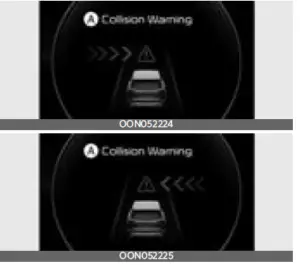
A: Collision Warning
Forward collision warning will alert the driver with a Forward safety warning light ( ), a warning message, an audible warning, and steering wheel vibration.
warning will be activated in the following conditions.
- Your driving speed: Approximately 6~19 mph (10~30 km/h)
- Crossing vehicle speed: Approximately 10~37 mph (15~60 km/h)
Emergency braking
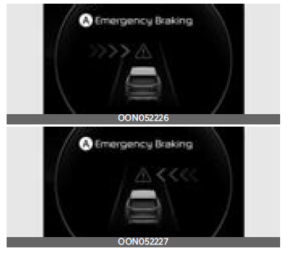
A: Emergency Braking
Emergency braking will alert the driver with a Forward safety warning light ( ), a warning message, and an audible warning. The brake assist will be activated to help avoid a collision with an oncoming vehicle.
Emergency braking will be activated in the following conditions.
- Your driving speed: Approximately 6~19 mph (10~30 km/h)
- Crossing vehicle speed: Approximately 10~37 mph (15~60 km/h) Stopping vehicle and ending brake control

A: Drive carefully
When the vehicle is stopped due to emergency braking, the warning message will appear on the cluster.
For your safety, the driver should depress the brake pedal immediately and check the surroundings.
- Brake control will end after the vehicle is stopped by emergency braking for approximately 2 seconds.
CAUTION
If the collision angle with the crossing vehicle is beyond a certain range, Junction Crossing Warning and control may be late or may not operate.
NOTICE
You can turn off the audible warning by pressing the hazard warning flasher during a Collision warning or Emergency braking.
Lane-change oncoming function (if equipped)
Warning and control
The Lane-change oncoming function is warned and controlled by the following level.
- Collision warning
- Emergency steering
Collision warning

A: Collision Warning
A collision warning will alert the driver with a Steering warning light ( ), a warning message, an audible warning, and steering wheel vibration.
A collision warning will be activated in the following conditions.
- Your driving speed: Approximately 25~90 mph (40~145 km/h)
- Oncoming vehicle speed: Approximately above 6 mph (10 km/h)
- Relative speed: Approximately below 124 mph (200 km/h)
Emergency steering

A: Emergency Steering
Emergency steering will alert the driver with a Steering warning light ( ), a warning message, and an audible warning. The steering assist will be activated to help avoid a collision with an oncoming vehicle or powered two-wheelers.
Emergency steering will be activated in the following conditions.
- Your driving speed: Approximately 25~90 mph (40~145 km/h)
- Oncoming vehicle speed: Approximately above 6 mph (10 km/h)
- Relative speed: Approximately below 124 mph (200 km/h)
Lane-change side function (if equipped)
Warning and control
The Lane-change side function is warned and controlled by the following level.
- Collision warning
- Emergency steering
Collision warning
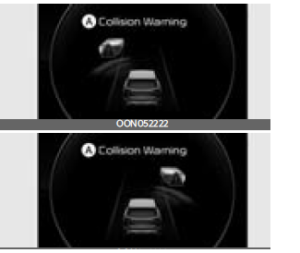
A: Collision Warning
A collision warning will alert the driver with a Steering warning light ( ), a warning message, an audible warning, and steering wheel vibration.
Emergency steering will be activated in the following conditions.
- Your driving speed: Approximately 25~90 mph (40~145 km/h)
Emergency steering
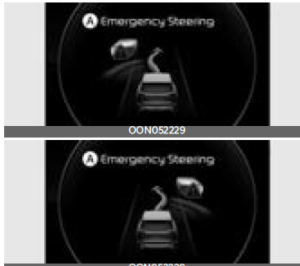
A: Emergency Steering
Emergency steering will alert the driver with a Steering warning light ( ), a warning message, an audible warning, and steering wheel vibration. Emergency steering will be activated in the following conditions.
- Your driving speed: Approximately 25~90 mph (40~145 km/h)
- Vehicle or powered two-wheeler in the next lane: Driving
WARNING
- The lane-Change Side function does not operate if the oncoming vehicle from the front side is stopped.
- The detecting area of the front and rear corner radar is determined by a standard lane width of the standard road. The warning may appear from the vehicle driving in the next lane for narrow roads. Or, the warning may not appear due to not detecting vehicles on the next lane for wide roads.
- Lane change side function is deactivated in the following conditions:
- Approaching to next lane for a standard amount of distance
- Getting away from the collision hazard direction
- Sharply steering the vehicle
- Depressing the brake pedal
- Forward Collision-Avoidance Assist is operating
- Getting away from the collision hazard direction
- Sharply steering the vehicle
- Depressing the brake pedal
- Forward Collision-Avoidance Assist is operating
- After Lane change side function is activated or lane change is done, move your vehicle to the center of the lane afterwards. The lane change side function will not operate when the vehicle is not being driven on the center of the lane.
NOTICE
If emergency steering is likely to cause additional collisions, the vehicle will alert the driver only with a collision warning.
Evasive Steering Assist function (if equipped)
Warning and Control
The Evasive Steering Assist function is warned and controlled by the following level.
- Emergency Steering
Emergency Steering (Driver steering assist)
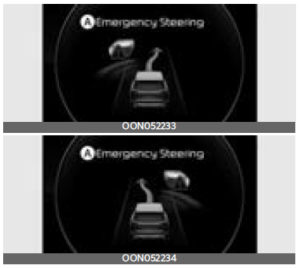
A: Emergency Steering
Emergency steering will alert the driver with a Steering warning light ( ), a warning message, an audible warning, and steering wheel vibration. If a possible collision with a vehicle ahead, pedestrians, cyclists, and a powered two-wheeler is detected and the driver steers to avoid the collision, the vehicle will assist the driver in steering.
Emergency Steering will be activated in the following conditions.
- Your driving speed: Approximately 25~53 mph (40~85 km/h)
Emergency Steering (Evasive steering assist)

A: Emergency Steering
Emergency steering will alert the driver with a Steering warning light ( ), a warning message, an audible warning, and steering wheel vibration. If there is a risk of collision with vehicles, pedestrians, cyclists and powered two-wheelers in front and your vehicle already exceeded the emergency braking speed limit, the steering will be assisted to help prevent collision when the driver steers the vehicle to avoid collision.
Emergency Steering will be activated in the following conditions.
- Your driving speed: Approximately 40~47 mph (65~75 km/h)
CAUTION
- The steering wheel may turn automatically when emergency steering is operating.
- Emergency steering will automatically cancel when risk factors disappear. If necessary, the driver must steer the vehicle.
- Emergency steering may not operate or may cancel during operation if the steering wheel is held tight or steered in the opposite direction.
- When steering is assisted to avoid collision with a vehicle, pedestrian and cyclist, Evasive steering assist will be canceled if collisions with other objects (vehicles, pedestrians, cyclists, or powered two-wheelers) are expected.
- Evasive steering assist may not operate if space to avoid collision in the driving lane is insufficient.
2023 Kia Telluride Specs, Price, Features and Mileage (Brochure)
WARNING
- For your safety, change the Settings after parking the vehicle at a safe location.
- Forward Collision-Avoidance Assist does not operate in all situations or cannot avoid all collisions.
- The driver should hold the responsibility to control the vehicle. Do not solely depend on Forward Collision-Avoidance Assist. Rather, maintain a safe braking distance, and if necessary, depress the brake pedal to reduce driving speed or to stop the vehicle.
- Never deliberately operate Forward Collision-Avoidance Assist on people, objects, etc. It may cause serious injury or death.
- Forward Collision-Avoidance Assist may not operate if the driver depresses the brake pedal to avoid collision.
- Depending on the road and driving conditions, Forward Collision-Avoidance Assist may warn the driver late or may not warn the driver.
- During Forward Collision-Avoidance Assist operation, the vehicle may stop suddenly injuring passengers and shifting loose objects. Always have the seat belt on and keep loose objects secured.
- If any other function’s warning message is displayed or an audible warning is generated, the Forward Collision-Avoidance Assist warning message may not be displayed and an audible warning may not be generated.
- You may not hear the warning sound of Forward Collision-Avoidance Assist if the surrounding is noisy. Adjust the warning volume vehicle appropriately, and always be aware of the surroundings and drive safely.
- Forward Collision-Avoidance Assist may turn off or may not operate properly or may operate unnecessarily depending on the road conditions and the surroundings.
- Even if there is a problem with Forward Collision-Avoidance Assist, the vehicle’s basic braking performance will operate properly.
- During emergency braking, braking control by Forward Collision-Avoidance Assist will automatically cancel when the driver excessively depresses the accelerator pedal or sharply steers the vehicle.
CAUTION
- The surroundings and pedestrians, cyclists, other vehicles, or powered two-wheelers in front of you may affect the speed or detection range to operate Forward Collision-Avoidance Assist, resulting in Forward Collision-Avoidance Assist temporarily limited or disabled.
- Forward Collision-Avoidance Assist will operate under certain conditions by determining the risk level depending on the surroundings and other vehicles’ driving directions or speed.
- Driving at excessively higher or lower speeds than other vehicles can temporarily limit or disable Forward Collision-Avoidance Assist.
- When a collision with a surrounding vehicle is expected, Lane-change oncoming, Lane-change side and Evasive steering assist functions will only warn the driver. (if equipped)
NOTICE
- When a collision is imminent, the Forward Collision-Avoidance Assist may assist the driver with brakes if the driver fails to brake enough.
- The images or colors may be displayed differently depending on the specifications of the instrument cluster or theme.
Forward Collision-Avoidance Assist malfunction and limitations
Forward Collision-Avoidance Assist malfunction

A: Check forward safety systems

A: Check Forward/Side Safety system When Forward Collision-Avoidance Assist is not working properly, the warn-ing message will appear, and the yellow ( ), ( ) and ( ) warning lights will appear on the cluster. Have the vehicle inspected by an authorized Kia dealer.
Forward Collision-Avoidance Assist disabled

A: Forward Safety system disabled. Radar blocked

A: Forward Safety systems disabled. Camera obscured
When the front windshield where the front view camera is located, front radar cover, bumper or sensor is covered with foreign material, such as snow or rain, it can reduce the detecting performance and temporarily limit or disable Forward Collision-Avoidance Assist. If this occurs the warning message, and the yellow ( ), ( ) and ( ) warning lights will appear on the cluster.
Forward Collision-Avoidance Assist will operate properly when snow, rain or foreign material is removed.
If Forward Collision-Avoidance Assist does not operate properly after obstruction (snow, rain, or foreign material) is removed (including trailer, carrier, etc. from the rear bumper), have the vehicle inspected by an authorized Kia dealer.
WARNING
- Even though the warning message or warning light does not appear on the cluster, Forward Collision-Avoidance Assist may not properly operate.
- Forward Collision-Avoidance Assist may not properly operate in an area (e.g. open terrain), where there is nothing to detect, or the detecting sensor is covered in foreign material after turning ON the vehicle.
- Even if restarting the vehicle with the sensors blocked or malfunctioned, Forward Collision-Avoidance Assist may not properly operate as the function maintains the last setting.
Limitations of Forward Collision-Avoidance Assist
Forward Collision-Avoidance Assist may not operate properly, or it may operate unexpectedly under the following circumstances:
- The detecting sensor or the surroundings are contaminated or damaged
- The temperature around the front view camera is high or low due to surrounding environment
- The camera lens is contaminated due to tinted, filmed or coated windshield, damaged glass, or sticky foreign material (sticker, bug, etc.) on the glass
- Moisture is not removed or frozen on the windshield
- Washer fluid is continuously sprayed, or the wiper is on
- Driving in heavy rain or snow, or thick fog
- The field of view of the front view camera is obstructed by sun glare
- Street light or light from oncoming traffic is reflected on the wet road surface, such as a puddle on the road
- An object is placed on the dashboard
- Your vehicle is being towed
- The surrounding is very bright or the surrounding is very dark, such as in a tunnel, etc.
- The brightness changes suddenly, for example when entering or exiting a tunnel
- The brightness outside is low, and the headlamps are not on or are not bright
- Only part of the vehicle, powered two-wheeler, pedestrian or cyclist is detected
- The vehicle in front is a bus, heavy truck, truck with an unusually shaped cargo, trailer, etc.
- The vehicle or powered two-wheeler in front has no tail lights, tail lights are located unusually, etc.
- The brightness outside is low, and the tail lamps are not on or are not bright
- The rear of the front vehicle is small or the vehicle does not look normal, such as when the vehicle is tilted, over-turned, or the side of the vehicle is visible, etc.
- The front vehicle’s ground clearance is low or high
- A vehicle, powered two-wheeler, pedestrian or cyclist suddenly cuts in front
- The bumper around the front radar is impacted, or damaged or the front radar is out of position
- The temperature around the front radar is high or low
- Driving through a tunnel or iron bridge
- Driving in vast areas where there are few vehicles or structures (for example, desert, meadow, suburb, etc.)
- Driving near areas containing metal substances, such as a construction zone, railroad, etc.
- A material is near that reflects very well on the front radar, such as a guardrail, nearby vehicle, etc.
- The cyclist in front is on a bicycle made of material that does not reflect on the front radar
- The vehicle or powered two-wheeler in front is detected late
- The vehicle or powered two-wheeler in front is suddenly blocked by an obstacle
- The vehicle or powered two-wheeler in front suddenly changes lane or suddenly reduces the speed
- The vehicle or powered two-wheeler in front is bent out of shape
- The vehicle in front is covered with snow
- You are departing or returning to the lane
- Unstable driving
- You are on a roundabout and the vehicle or powered two-wheeler in front is not detected
- You are continuously driving in a circle
- The vehicle in front has an unusual shape
- The vehicle in front is driving uphill or downhill
- The pedestrian or cyclist is not fully detected, for example, if the pedestrian is leaning over or is not fully walking upright
- The pedestrian or cyclist is wearing clothing or equipment that makes it difficult to detect

The illustration above shows the image the front view camera and front radar are capable of detecting as a vehicle, powered two-wheeler, pedestrian and cyclist.
- The pedestrian or cyclist in front is moving very quickly
- The pedestrian or cyclist in front is short or is posing a low posture
- The pedestrian or cyclist in front has impaired mobility or moving intersected with the driving direction
- There is a group of pedestrians, cyclists or a large crowd in front
- The pedestrian or cyclist is wearing clothing that easily blends into the background, making it difficult to detect
- The pedestrian or cyclist is difficult to distinguish from the similarly shaped structure in the surroundings
- You are driving by a pedestrian, cyclist, traffic signs, structures, etc., near the intersection
- When driving in the following places
- Driving through steam, smoke or shadow
- Driving through a tunnel or iron bridge
- Driving in large areas where there are few vehicles or structures (i.e. desert, meadow, suburb, etc.)
- Driving in a parking lot
- Driving through toll gate, construction areas, partially paved roads, bumpy roads, speed bumps, etc.
- Driving near areas containing metal substances, such as a construction zone, railroad, etc.
Driving on an inclined road, curved road, etc. - Driving through a roadside with trees or streetlights
- Driving through a narrow road where trees or grass are overgrown
- There is interference by electromagnetic waves, such as driving in an area with strong radio waves or electrical noise
- The adverse road conditions cause excessive vehicle vibrations while driving
- Your vehicle height is low or high due to heavy loads, abnormal tire pressure, etc.
Junction crossing, Lane-change oncoming, Lane-change side, Evasive steering assist function (if equipped)
- The temperature around the front corner radar or rear corner radar is high or low
- A trailer or carrier is installed around the rear corner radar
- The front corner radar or rear corner radar is covered with snow, rain, dirt, etc.
- The bumper around the front corner
- The front corner radar or rear corner radar is covered with snow, rain, dirt, etc.
- The bumper around the front corner radar or rear corner radar is covered with objects, such as a bumper sticker, bumper guard, bike rack, etc.
- The bumper around the front corner radar or rear corner radar is impacted, damaged or the radar is out of position
- The front corner radar or rear corner radar is blocked by other vehicles, walls or pillars
- Driving on a highway (or motorway) ramp
- Driving on a road where the guardrail wall is in a double structure
- The other vehicle drives very close behind your vehicle, or the other vehicle passes by your vehicle in close proximity
- The speed of the other vehicle is very fast that it passes by your vehicle in a short time
- Your vehicle passes by the other vehicle
- Your vehicle has started at the same time as the vehicle next to you and has accelerated
- The vehicle in the next lane moves two lanes away from you, or when the vehicle two lanes away moves to the next lane from you
- If the following object is detected:
- A motorcycle or bicycle is detected
- A vehicle such as a flat trailer is detected
- A big vehicle such as a bus or truck is detected
- A small moving obstacle such as a pedestrian, animal, shopping cart or baby stroller is detected
- A vehicle with low height such as a sports car is detected
- When a lane or lane cannot be detected:
- The lane is difficult to see due to foreign material, such as rain, snow, dust, sand, oil and water puddles
- The color of the lane marking is not distinguishable from the road or wet surface
- There are markings on the road near the lane or the markings on the road looks similar to the lane markings
- The shadow is on the lane marking by a median strip, trees, guardrail, noise barriers, etc.
- The lane number increases or decreases, or the lane markings are crossing
- There are more than two-lane markings on the road
- The lane markings are complicated or a structure substitutes for the lines, such as a construction area
- There are road markings, such as zigzag lanes, crosswalk markings and road signs
- The lane suddenly disappears, such as at the intersection
- The lane is very wide or narrow
- There is a curb or road edges without a lane
- The vehicle in front is driving with one side on the lane marking
- The distance to the front vehicle is extremely short or the vehicle in front is covering the lane marking (or road edge)
WARNING
- Driving on a curved road

Forward Collision-Avoidance Assist may not detect other vehicles, powered two-wheelers, pedestrians or cyclists in front of you when driving on curved roads adversely affecting the performance of the sensors. This may result in no warning, braking assist or steering assist (if equipped) when necessary.
When driving on a curve, you must maintain a safe braking distance, and if necessary, steer the vehicle and depress the brake pedal to reduce your driving speed in order to maitain a safe distance.

Forward Collision-Avoidance Assist may detect a vehicle, powered two-wheeler, pedestrian or cyclist in the next lane or outside the lane when driving on a curved road.
If this occurs, Forward Collision-Avoidance Assist may unnecessarily warn the driver and control the brake or steering (if equipped). Always check the traffic conditions around the vehicle.
- Driving on an inclined road

Forward Collision-Avoidance Assist may not detect other vehicles, powered two-wheelers, pedestrians or cyclists in front of you while driving uphill or downhill, adversely affecting the performance of the sensors.
This may result in unnecessary warnings, braking assist, steering assist (if equipped) or no warning, braking assist, steering assist (if equipped) when necessary.
Also, vehicle speed may rapidly decrease when a vehicle, powered two-wheeler, pedestrian or cyclist ahead is suddenly detected.
Always have your eyes on the road while driving uphill or downhill and if necessary, steer your vehicle and depress the brake pedal to reduce your driving speed in order to maintain a safe distance.
- Changing lanes
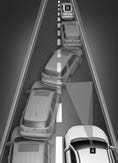
[A]: Your vehicle,
[B]: Lane changing vehicle
When a vehicle (B) moves into your lane from an adjacent lane, it cannot be detected by the sensor until it is in the sensor’s detection range.
Forward Collision-Avoidance Assist may not immediately detect the vehicle when the vehicle changes lanes abruptly. In this case, you must maintain a safe braking distance, and if necessary, steer your vehicle and depress the brake pedal to reduce your driving speed in order to maintain a safe distance.

[A]: Your vehicle,
[B]: Lane changing vehicle,
[C]: Same lane vehicle
When a vehicle (B) in front of you merges out of the lane, Forward Collision-Avoidance Assist may not immediately detect the vehicle (C) that is now in front of you. In this case, you must maintain a safe braking distance, and if necessary, steer your vehicle and depress the brake pedal to reduce your driving speed in order to maintain a safe distance.
- Detecting vehicle
 If the vehicle in front of you has cargo that extends rearward from the cab, or when the vehicle in front of you has higher ground clearance, additional special attention is required. Forward Collision-Avoidance Assist may not be able to detect the cargo extending from the vehicle. In these instances, you must maintain a safe braking distance from the rearmost object, and if necessary, steer your vehicle and depress the brake pedal to reduce your driving speed in order to maintain distance.
If the vehicle in front of you has cargo that extends rearward from the cab, or when the vehicle in front of you has higher ground clearance, additional special attention is required. Forward Collision-Avoidance Assist may not be able to detect the cargo extending from the vehicle. In these instances, you must maintain a safe braking distance from the rearmost object, and if necessary, steer your vehicle and depress the brake pedal to reduce your driving speed in order to maintain distance.
WARNING
- When you are towing a trailer or another vehicle, turn off Forward Collision-Avoidance Assist for safety reasons.
- Forward Collision-Avoidance Assist may operate if objects that are similar in shape or characteristics to vehicles, powered two wheeler, pedestrians and cyclists are detected.
- Forward Collision-Avoidance Assist does not operate on bicycles, or smaller wheeled objects, such as lug-gage bags, shopping carts, or strollers.
- Forward Collision-Avoidance Assist may not operate properly if interfered by strong electromagnetic waves.
- Forward Collision-Avoidance Assist may not operate for 15 seconds after the vehicle is started, or the front view camera is initialized.
This device complies with Part 15 of the FCC rules.
Operation is subject to the following three conditions:
- This device may not cause harmful interference, and
- This device must accept any interference received, including interference that may cause undesired operation.
- Changes or modifications not expressly approved by the party responsible for compliance could void the user’s authority to operate the device.
Radiofrequency radiation exposure information:
This equipment complies with FCC radiation exposure limits set forth for an uncontrolled environment. This equipment should be installed and operated with a minimum distance of 8 in (20 cm) between the radiator (antenna) and your body.
This transmitter must not be collocated or operating in conjunction with any other antenna or transmitter.
FAQ
Forward Collision-Avoidance Assist (FCA) with Sensor Fusion is an advanced safety feature that helps prevent frontal collisions by detecting obstacles and automatically applying the brakes if necessary.
FCA with Sensor Fusion combines data from various sensors, including radar and cameras, to detect vehicles, pedestrians, and obstacles in the vehicle’s path. It then alerts the driver and can apply the brakes to avoid or mitigate a collision.
Yes, in most cases, the driver can override FCA by taking control of the steering or braking.
FCA with Sensor Fusion is typically active by default, but the driver may have the option to enable or disable it through vehicle settings.
FCA with Sensor Fusion may work at a range of speeds, including both low and high speeds, to detect potential collisions.
FCA with Sensor Fusion is designed to detect both vehicles and pedestrians in the path of the vehicle.
FCA with Sensor Fusion can provide visual and audible warnings to alert the driver of an impending collision.
The activation distance of FCA with Sensor Fusion can vary, but it often starts to warn or intervene when it detects a potential collision within a certain range.
While FCA with Sensor Fusion is designed to help prevent or mitigate collisions, it may not be able to prevent all collisions in every situation, particularly in extreme conditions.
FCA with Sensor Fusion is designed to work in various weather conditions but may have limitations in extremely adverse conditions, such as heavy fog or blizzard conditions.
No, FCA with Sensor Fusion is a supplementary safety feature and is not a substitute for attentive driving. Drivers should always remain vigilant and ready to take control of the vehicle.
Some models of the 2023 Telluride may allow for customization of FCA settings, such as sensitivity and activation thresholds, to better suit the driver’s preferences.
FCA with Sensor Fusion may have limitations in certain conditions, such as very low visibility, extremely bright sunlight, or situations where the sensors are obstructed.
FCA with Sensor Fusion primarily focuses on the forward direction but may have some lateral coverage to detect potential cross-traffic collisions.
FCA with Sensor Fusion may be available on certain trim levels or as part of specific safety packages, so its availability can vary depending on the trim and options selected.
Useful Link
View Full User Guide: Kia Telluride 2023 User Guide
Download Manuals: https://owners.kia.com/content/owners/en/manuals.html
2023 Kia Telluride Specs, Price, Features and Mileage (Brochure)

